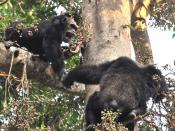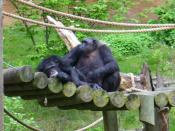Imitation is a complex form of social learning. Individuals benefit immensely from social learning. To learn a new task by copying (imitating) skilled performers is a clever way to avoid making unnecessary mistakes in order to search for the correct solutions. It reduces the amount of time spend on learning how to solve a particular task or situation. It also speeds up the process of learning of motor skills and "environmental affordances" in the world. The information obtained can then be passed on to other individuals and further generations.
As will be described in this essay observational learning can occur in a variety of forms:
Stimulus enhancement:
This is an inbuilt structural observational learning.
House cats, for example, usually catch and eat their prey outside their home. However, when they have young infants they tend to bring back their prey. The first few times the prey is dead and then alive.
This provides a framework, where parents unintentionally provide opportunities for learning to take place. The young infant can watch and learn (lecture notes 2001). In this essay an example of stimulus enhancement is: The chimpanzee mother leaving nuts and tools around for the young.
Response enhancement:
If an animal sees another conspecific forming a particular response to a situation, then this animal it is more likely to behave in the same way. An example of Blackbirds mobbing behaviour will be given.
Imitation proper:
Copying the demonstrator. This is particular the case in humans. When a young child was put together with a chimp, it was imitating the chimp's actions rather then vice versa. Also see examples of abandoned children.
Emulation:
" Copying only occurs at the level of outcome of an action sequence"(Tomasello 1990). Some examples are nut cracking, honey fishing, and ant dipping. Here the observer learns that...


